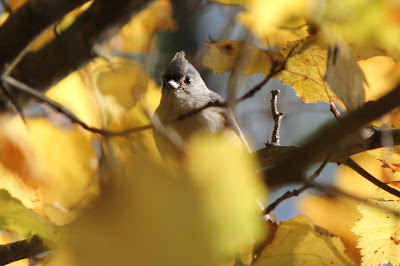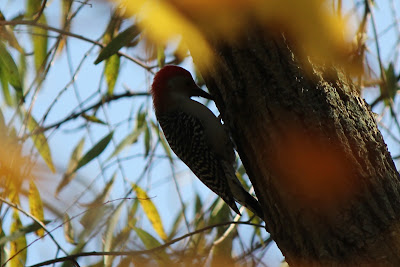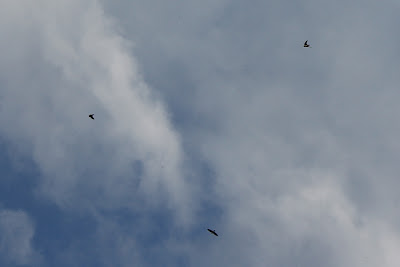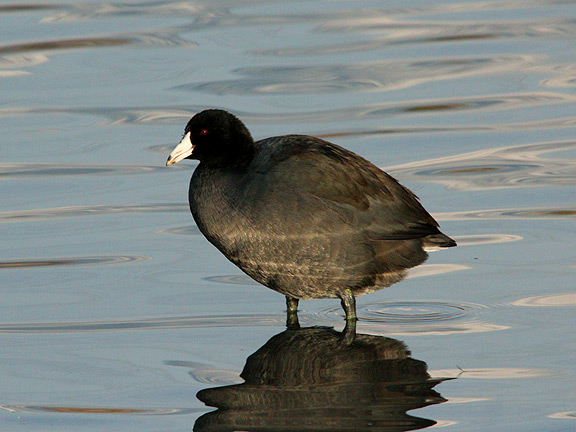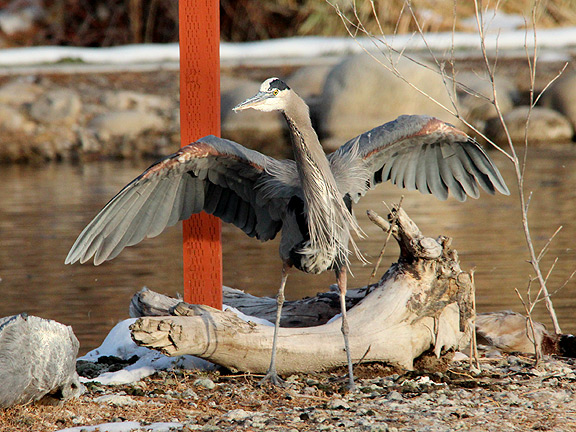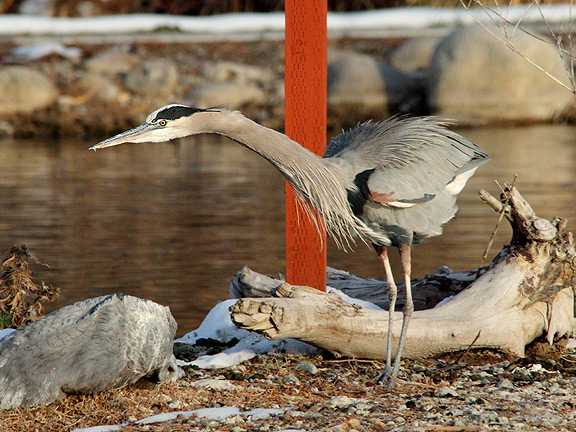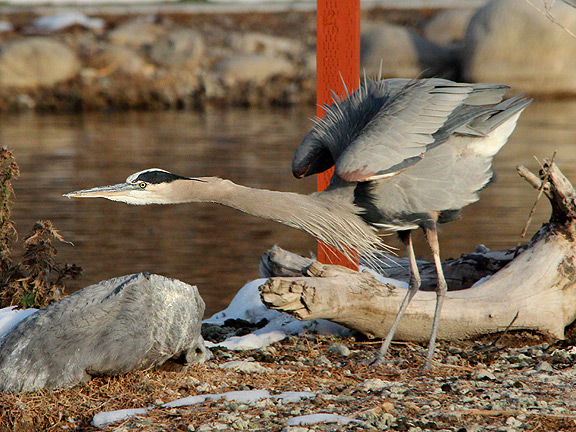Panorama view from Giant Mountain
Last month I returned home to Western New York for the first time since I moved out to Utah. While the main reason for going home was to see my family and friends, I was looking forward to seeing some bird friends that I haven't seen in almost a year as well. While it is always nice to find rarities when you are living in an area, I was looking forward to seeing birds that were among easiest to see: Blue Jays, Cardinals, Tufted Titmice, Red-bellied Woodpeckers and the such. I had found myself missing the everyday birds the most. I also decided that I should have a goal for the week that I was home and it was to see 100 total species. I wasn't sure if this was doable since it seemed a little ambitious given that it was late for fall migration and a little early for winter species to start showing up.
After I had gotten home and caught up with my family, I went birding in one of my favorite spots: my Grandma's yard. My grandma's house is right on the Erie Canal, with a large track of woods on the property so the birding is amazing. There have been over 100 species of birds seen at her house including over 15 species of warbler, but I managed to add a new yard bird once I started walking around: a Swamp Sparrow in a little patch of cattails.
A poor shot of a Swamp Sparrow at my Grandma's house.
That first day at her house I got to see a Red-bellied Woodpecker and Tufted Titmouse plus other nice birds like White-breasted Nuthatch and Golden-crowned Kinglet (it was weird not having to venture up in the mountains to see them).
Nice to see White-breasted Nuthatches again.
I was excited to go birding with my Aunt Cindy who got me hooked on birding when I was very young. We headed up to do some birding up near Lake Ontario. There are great marshes up there
to bird as well as some mudflats this year due to low lake levels. There were some nice birds in the area including Wood Ducks and Bonaparte's Gulls but the best bird of the day was a late Common Tern on a beach at the lake.
Common Tern at Charlotte Beach on Lake Ontario
My next bird day of birding came when I went to do some birding up near Lake Ontario. There are great marshes up there to bird as well as some mudflats this year due to low lake levels. At one such mudflat I had 7 species of shorebirds: Black-bellied Plover, Killdeer, Greater Yellowlegs, Least Sandpiper, Pectoral Sandpiper, Dunlin, and Wilson's Snipe. The number of snipe was impressive with almost two dozen present. Up on a spit on the lake, I hit some more target birds: Mute Swan (pretty much the first time in my life I was excited to see them), American Black Duck, "Red" Fox Sparrow, and Northern Cardinal.
Mute Swans are also not fans of Mute Swans
A common sight back home: A Tufted Titmouse
Another eastern specialty: Red-bellied Woodpecker
Over on a spit on the other side of the bay, I found 2 more target species: Great Black-backed Gull and Winter Wren, along with at least 4 Lesser Black-backed Gulls, a very high count.

2
Lesser Black-backed Gulls on either side of the picture
My next big birding adventure would be with my brother Josh in a much different locale: the Adirondack Mountains. Although at their tallest they are only a bit over 5100 feet, nearby areas are almost at sea level which make the mountains almost as prominent as the Wasatch Mountains out here with similar altitude gains when hiking of about 1000 feet of elevation gain per mile. Adirondack birding is known for its many boreal specialties that have their southern most range in the mountains.
Starting the hike, we flushed a Ruffed Grouse that only I saw, but later on my brother would see one for himself. About halfway up Giant Mountain, I heard a familiar call and soon located the birds making it: White-winged Crossbills! They are an uncommon breeder in the Adirondacks and currently there is an irruption of this species in the east so I'm not sure if these were resident birds or not. After finally making it up to the summit of Giant Mountain and having a snack, I heard another familiar call, but was shocked at the species making it: Snow Buntings. I am used to seeing these along the lake (I would see some the next day there) or in fields that had recently been spread with manure, but never on top of a mountain.
My brother Josh and I on Giant Mountain
We continued on to climb up Rocky Peak Ridge. While descending Giant Mountain, we ran into a flock of an uncommon Adirondacks species I also didn't expect to see: Boreal Chickadees. There were several of these brown chickadees flitting about making it hard to get great views or pictures but they were still a delight to see again. We kept hiking and reached the summit of Rocky Peak Ridge to realize that someone else had beaten us up there:
Snow Bunting on Rocky Peak Ridge
It was fun getting really close view of these birds, especially with such a gorgeous backdrop.
Snow Buntings on Rocky Peak Ridge summit
As we hung out on this summit we also had some flyby Common Ravens, another species my brother had never seen before.
Common Ravens are fairly common in the Adirondacks
The next day back in Western New York, I decided to head up to the lake watch at Hamlin Beach State Park to try and add to my species list. It turned out to be a great day not only for birds, but birders as well as there were many Rochester area birders up at the lake watch as well. The main highlight were the tons of Cave Swallows passing by- over 100 were tallied there that day. In recent years, Cave Swallows have become regular along Lake Ontario in fall with most of them migrating west. I have to admit to scoping a nearby Eastern Bluebird when some of the Cave Swallows were flying by, but I hope the other birders understood since I haven't seen one in quite some time.
3 Cave Swallows fly west past the lake watch
There were many other highlights though from the day. 4 species of geese (Canada, Cackling, Brant and Snow). All 3 scoter species migrating by in large numbers with many Black and Surf Scoters which are usually the least common. Long-tailed Ducks. Red-throated and Common Loons. 4 jaegers (probably Parasitic, they were far out there). One Merlin. Also a large flight of Robins and Goldfinches filled the sky. Personally this was one of my better days of birding in my life.
Flock of over 100 Brant
Snow Geese flying by
The next day, I got to go birding with my aunt on a weekday. A rarity in itself since it was the first time she took off a day of work to go birding. I have been trying to get her to take one off during spring migration but she had held out until now. We were going to head out to Montezuma NWR, but before we could leave, my grandma's yard held some more surprises. After noticing a flock of Yellow-rumped Warblers, we caught sight of 4 Northern Mockingbirds all going after each other in a burning bush. While looking at that bush we saw 2 Eastern Bluebirds. The bluebirds flew off and while trying to refind them, I saw a Pileated Woodpecker in the woods. We ended up seeing 5 woodpecker species basically at the same time with Downy, Hairy, Red-bellied and Northern Flicker rounding out the list. Not a bad way to start some birding.
Montezuma NWR also turned out to be a goose haven. At the visitor center, we picked out 2 Cackling Geese amongst the many Canadas present.
Cackling Geese
Without warning, all the geese took off, leaving me simultaneously ducking for cover from geese poo and looking for what scared them. We soon saw the culprit- a gorgeous adult Bald Eagle.
Look out below!
We also got to see Greater White-fronted Geese, Snow Geese and Ross's Geese which gave me 6 species of geese in 2 days.
Snow Geese with some Blue morphs mixed in and probably some Ross's.
There were other nice sightings including my 3 group of Snow Buntings that week, American Pipits, 11 Sandhill Cranes, 7 species of shorebird, and 10 species of duck. I found 2 more target species: Rusty Blackbirds and Common Grackles.
Rusty Blackbird
Common Grackle flock
It was a great last day in a week full of birding and I couldn't have had better company than the person who fostered the love of birds in me. I managed to fly out just before Superstorm Sandy hit the area, although I had to change flights and drive to Buffalo since there was no way I was flying out of JFK!
I ended up surpassing my goal, seeing 109 species while I was home- a great number considering it was near the end of October. And I got to go birding in the places most special to me that made me the birder I am today. I am looking forward to the next time I get to go home again and the birds I will get to see then. Spring migration anyone?
Labels: New York, Travel, trip reports





